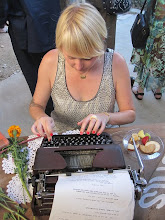Journey to the West. Four-hundred and some years later, this classic piece of Chinese literature has been presented in a new light. A Buddhist monk makes his pilgrimage to India to get his hands on some quite righteous spiritual scriptures. A few disciples, including a badass monkey, help him along the way.
I’m giving an oh, so brief synopsis of a book comprised of 100 chapters. But the BBC told the story in an equally simple way (here’s a bit on how they did it). In promoting their coverage of the upcoming Beijing Olympics, they turned the tale into a two-minute gem, ending - after some fabulous Olympic-style leaps, twists and escapes - with the lighting of the mighty torch. The network partnered with fellow Englishmen Jamie Hewlett and Damon Albarn. No strangers to collaboration, they're the brains behind Gorillaz and also helped co-create the opera Monkey: Journey to the West - this looks like it rocks, by the way. And in Albarn's case, let's not forget about the amazing music of Brit supergroup The Good, the Bad and the Queen.
The visuals are based off of Monkey (or Monkey Magic!), a popular 1970s animated series. Maybe that choice was rooted in nostalgia. Regardless, it's much more interesting than the traditional glorified athlete promo. I think it’s a lovely retelling of an age-old story. Condensed, yes, but attention spans are not what they used to be. Is that because of digital platforms? I'll answer that when I have more time (to concentrate on the question). First, I need to get Monkey on my mobile.
Friday, July 25, 2008
Wednesday, July 16, 2008
Roll Computer
Radiohead’s new video for “House of Cards” uses no lights and no cameras. It was created with some dope real-time 3D recording technologies. They captured these 3D images using Geometric Informatics and two LIDAR (Light Detection and Ranging) scanners. One scanner was used for detailed information (like the Thom Yorke close-ups). It rotated 360 degrees and had 64 rotating lasers. The other was designed to pick up much wider geographic images, including the Florida terrain you see. No surprise that it took weeks to process the massive amount of raw data. Here’s more on how it was made.
The production crew (composed by and large of engineers) distorted some of the data with small bits of mirror. They also experimented with water and feathers. Added bonus: You can manipulate the video and download data to create your own visualizations. Nice.
Director James Frost said the thinking behind this project was to create a real feeling through something that was computer generated. It’s a reflection of our data driven society.
Radiohead rocks. (Special thanks to S.W. Taffy for the assistance embedding the video!)
The production crew (composed by and large of engineers) distorted some of the data with small bits of mirror. They also experimented with water and feathers. Added bonus: You can manipulate the video and download data to create your own visualizations. Nice.
Director James Frost said the thinking behind this project was to create a real feeling through something that was computer generated. It’s a reflection of our data driven society.
Radiohead rocks. (Special thanks to S.W. Taffy for the assistance embedding the video!)
Subscribe to:
Posts (Atom)
